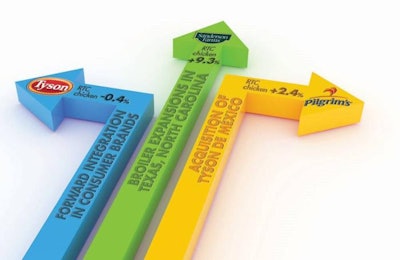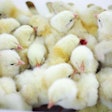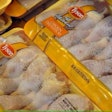
No. 1-ranked Tyson Foods, the largest producer of broiler chicken in the U.S., was one of only four broiler producers to register a reduction in ready-to-cook chicken production in 2015, according to WATT PoultryUSA’s Top Poultry Companies Rankings, but it was a stellar year for the Springdale, Arkansas-based producer of meat proteins.
Tyson Foods reduced average weekly RTC chicken production by 710,000 pounds but still out-produced its closest rival, Pilgrim’s, by almost 34 million pounds. The Springdale, Arkansas-based company slaughtered 33.41 million broilers at an average live weight of 5.75 pounds to produce 175.6 million RTC pounds of chicken on an average weekly basis in 2015.
Tyson Foods, in fact, achieved record earnings and sales in fiscal year 2015 – earning $3.15 per share and posting $40.6 billion in sales, including ringing up higher chicken sales. Yet, Tyson lowered chicken production in 2015. What’s at work here? This paradoxical performance, in part, reflects the fact that Tyson, along with other top US broiler companies, is redefining its business model to achieve profitable growth.
Extrinsic business factors, including lower feed ingredient costs, played a role in Tyson’s profitable results in 2015, but the purchase of Hillshire Brands in 2014 continues to reform Tyson as a consumer food products company and less a chicken, pork or beef producer. Tyson, in fact, is producing less and purchasing more chicken from other producers, especially during periods of weak market prices.
Tyson’s closest competitors – Pilgrim’s, Sanderson Farms and Perdue Farms – all of which grew chicken production in 2015 – are pursuing their own unique business strategies.
- The No. 2-ranked U.S. broiler producer, Pilgrim’s, slaughtered 28.85 million broilers weekly at an average live weight of 5.71 pounds to produce 141.67 million pounds of chicken, an increase of 2.4 percent over 2014. Losing out to Tyson Foods in the bidding for Hillshire Brands in 2014, Pilgrim’s purchased Tyson’s Mexican chicken operations in 2015 and takes on a higher multi-species, multi-national profile as a part of JBS.
- No. 3-ranked Sanderson Farms increased RTC chicken production by 12.6 percent, as operations began at its new Palestine and Freestone County, Texas, complex in February 2015. Construction is under way on a new broiler complex in St. Pauls, North Carolina, which is expected to begin operations in calendar 2017. Sanderson continues to pursue a broiler-centric, build-and-grow strategy designed for efficiency and keeping costs competitive.
- No. 4-ranked Perdue Foods slaughtered 12.99 million broilers weekly at an average live weight of 5.94 pounds to produce 61.74 million pounds of chicken, an increase of 9.3 percent over the previous year. Perdue, with diversification in turkey production and energy projects, continues to develop its capabilities in antibiotic-free broiler production.
Other top 10 broiler producers with increases
- No. 5-ranked Koch Foods reported it held production steady in 2015. Other top 10 broiler producers reporting increases in chicken production included the following:
- No. 6-ranked Wayne Farms raised RTC chicken production from 45.39 million to 47.68 million pounds weekly or by 5.0 percent.
- No. 7-ranked Mountaire Farms increased RTC chicken production from 43.75 million to 46.10 million pounds weekly or by 5.4 percent.
- No. 8-ranked House of Raeford Farms upped RTC chicken production from 26.44 million to 27.52 million pounds weekly or by 4.1 percent.
- No. 9-ranked Peco Foods increased RTC chicken production from 24.08 million to 26.53 million pounds weekly or by 10.2 percent.
- No. 10-ranked Keystone Foods raised RTC chicken production from 19.60 million to 20.80 million pounds weekly or by 6.1 percent.
Broiler chicken industry consolidation, 2005-15
As U.S. broiler producers intensify their focus on consumer differentiation and profitability, one of the most remarkable trends in the U.S. broiler industry is a cessation of consolidation among the top five firms in the last 10 years.
Production increases among top 10 broiler firms notwithstanding, the growth in mid-size broiler firms and the entrance and growth of smaller producers has continued.

Broiler chicken industry consolidation: 2005-15, shows the U.S. broiler industry is consolidating slowly among mid-size producers in the last 10 years. From 2005 through 2015 share held by the top three and top five firms fell slightly and rose most among firms ranked six through 10.
In 2015, for example, the largest percentage increases in RTC chicken production are by No. 24-ranked Farmer’s Pride (air-chilled, raised without antibiotics and organic chicken), No. 25-ranked OMP Foods (specializing in value-added and antibiotic-free chicken) and No. 26-ranked MBA Poultry (organic and free-range chicken).
The U.S. broiler industry is growing more diverse in the nature and size of producers and their products and business strategies.


















